
Tochigi is a city located in Tochigi Prefecture, in the northern Kantō region of Japan. As of May 2015, the city had an estimated population of 159,648, and a population density of 482 persons per km². Its total area is 331.50 square kilometres (127.99 sq mi). Because the city escaped war damage during World War II, many historical temples, traditional shops and kura remain in the city center. The city was awarded the "Utsukushii-machinami Taisho" prize from the Ministry of Land, Infrastructure, Transport and Tourism in 2009.

Mooka is a city located in Tochigi Prefecture, Japan. As of January 2017, the city had an estimated population of 79,660, and a population density of 476 persons per km². Its total area is 167.34 km². Moka is known for the Mooka Railway, which operates steam locomotives. The train line stretches from Shimodate, Ibaraki Prefecture to Motegi, Tochigi Prefecture. The town produces 7,000 tons of strawberries annually. The name of the city is given as "Moka City" per the city's official website; however, the local train station is "Mōka Station", and the direct transliteration of the city name into Hepburn romanization is "Mooka".

Tsuga is a genus of conifers in the subfamily Abietoideae. The common name hemlock is derived from a perceived similarity in the smell of its crushed foliage to that of the unrelated plant poison hemlock. Unlike the latter, Tsuga species are not poisonous.
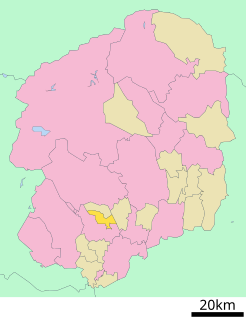
Tsuga was a town located in Shimotsuga District, Tochigi Prefecture, Japan.

Tsuga canadensis, also known as eastern hemlock, eastern hemlock-spruce or Canadian hemlock, and in the French-speaking regions of Canada as pruche du Canada, is a coniferous tree native to eastern North America. It is the state tree of Pennsylvania.

Tsuga heterophylla, the western hemlock or western hemlock-spruce, is a species of hemlock native to the west coast of North America, with its northwestern limit on the Kenai Peninsula, Alaska, and its southeastern limit in northern Sonoma County, California.
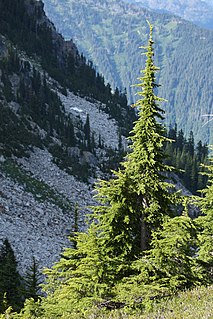
Tsuga mertensiana, known as mountain hemlock, is a species of hemlock native to the west coast of North America, with its northwestern limit on the Kenai Peninsula, Alaska, and its southeastern limit in northern Tulare County, California. Mertensiana refers to Karl Heinrich Mertens (1796–1830), a German botanist who collected the first specimens as a member of a Russian expedition in 1826-1829.
Nothotsuga is a genus of coniferous trees in the family Pinaceae endemic to China. Nothotsuga contains only one species, Nothotsuga longibracteata, commonly known as the bristlecone hemlock, which is found in southeastern China, in southern Fujian, northern Guangdong, northeast Guangxi, northeast Guizhou, and southwest Hunan.

Tsuga caroliniana, the Carolina hemlock, is a species of Tsuga, native to the Appalachian Mountains in southwest Virginia, western North Carolina, extreme northeast Georgia, northwest South Carolina, and eastern Tennessee. Its habitat is on rocky mountain slopes at elevations of 700–1,200 m (2,300–3,900 ft). The optimal growing condition is a partly shady area with moist but well-drained soil in a cool climate.

The Central Mountain Range, also known as the Zhongyang Range or Chungyang Range, is the principal range of mountains in Taiwan. It runs from the north of the island to the south. Due to this separation, connecting between the west and east is not very convenient. The tallest peak of the range is Xiuguluan Mountain, 3,860 m (12,664 ft).
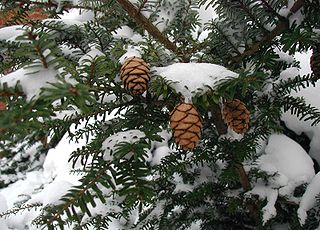
Tsuga diversifolia, commonly known as the northern Japanese hemlock, or in Japanese, kometsuga (米栂), is a species of conifer native to the Japanese islands of Honshū, Kyūshū, and Shikoku. In Europe and North America, the species is sometimes employed as tree for the garden and has been in cultivation since 1861.

Tsuga dumosa, commonly called the Himalayan hemlock or in Chinese, Yunnan tieshan, is a species of conifer native to the eastern Himalayas. It occurs in parts of Nepal, India,(Bhutan), Burma, Vietnam, Tibet, and China. Within its native range the tree is used for construction as well as for furniture. In Europe and North America, it is occasionally encountered as an ornamental species and was first brought to the United Kingdom in 1838.
Tsuga forrestii is a species of conifer in the Pinaceae family. It is considered as a variety of Tsuga chinensis by some. It grows in mixed forests in mountains and valleys of northeast Guizhou, southwest Sichuan, and northwest Yunnan, at altitudes of 2,000–3,000 m (6,600–9,800 ft).

Iwami-Tsuga Station was a railway station in Misato, Ōchi District, Shimane Prefecture, Japan, operated by West Japan Railway Company.
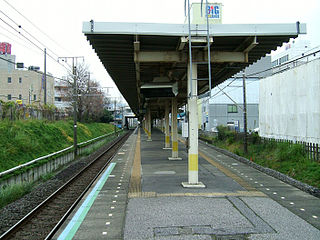
Tsuga Station is a railway station in Wakaba-ku, Chiba, Japan, operated by East Japan Railway Company and the Chiba Urban Monorail.
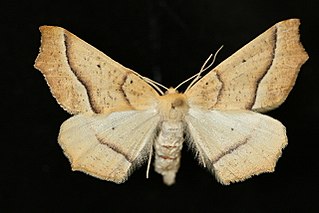
Tetracis pallulata is a moth of the family Geometridae. It is found from southern California north to British Columbia, east to Idaho and western Montana from near sea level to 2,200 meters.

Wakaba Ward is one of the six wards of the city of Chiba in Chiba Prefecture, Japan. As of April 2012, the ward had an estimated population of 151,593 and a population density of 1,800 persons per km². The total area was 84.21 km², making it the largest of the six wards of Chiba city.

Glen Spey is a hamlet in the town of Lumberland, Sullivan County, New York, United States. Its ZIP code is 12737. The town's name is in reference to the spring-filled ravines, or glens, that characterize the Delaware River tributaries in the area. There are waterfalls and shady Hemlock forests typical to the steep river valley terrain and many natural springs occur in the area.

Kazuhiro Tsuga is the current President of Panasonic.
Scared Rider Xechs is a Japanese otome game published by Red Entertainment. It was released in Japan on July 1, 2010 for the PlayStation 2. A fan disc titled Scared Rider Xechs: Stardust Lovers was released in 2011. The game was ported to the PlayStation Vita in 2015. A 12-episode anime television series adaptation by Satelight aired between July 5 and September 20, 2016.


















